Analyzing the Positive and Negative Impacts of Tourism on the World
VerifiedAdded on 2023/06/17
|9
|2392
|124
Essay
AI Summary
This essay provides a comprehensive analysis of the tourism industry, examining its economic, environmental, and socio-cultural impacts. It begins by outlining the development of contemporary tourism and the significant factors driving its growth, such as technology, demographic changes, and improved transportation. The essay then delves into the positive economic impacts, including employment generation and government revenue contribution, while also addressing negative aspects like economic leakage and infrastructure costs. Furthermore, it explores the environmental impacts, highlighting both the financial resources tourism can provide for conservation and the depletion of resources and increasing pollution it can cause. Finally, the essay discusses the socio-cultural impacts, noting the preservation of local culture alongside the potential decline in societal morality. The report concludes by emphasizing the multifaceted nature of tourism and its complex effects on various aspects of society and the environment.
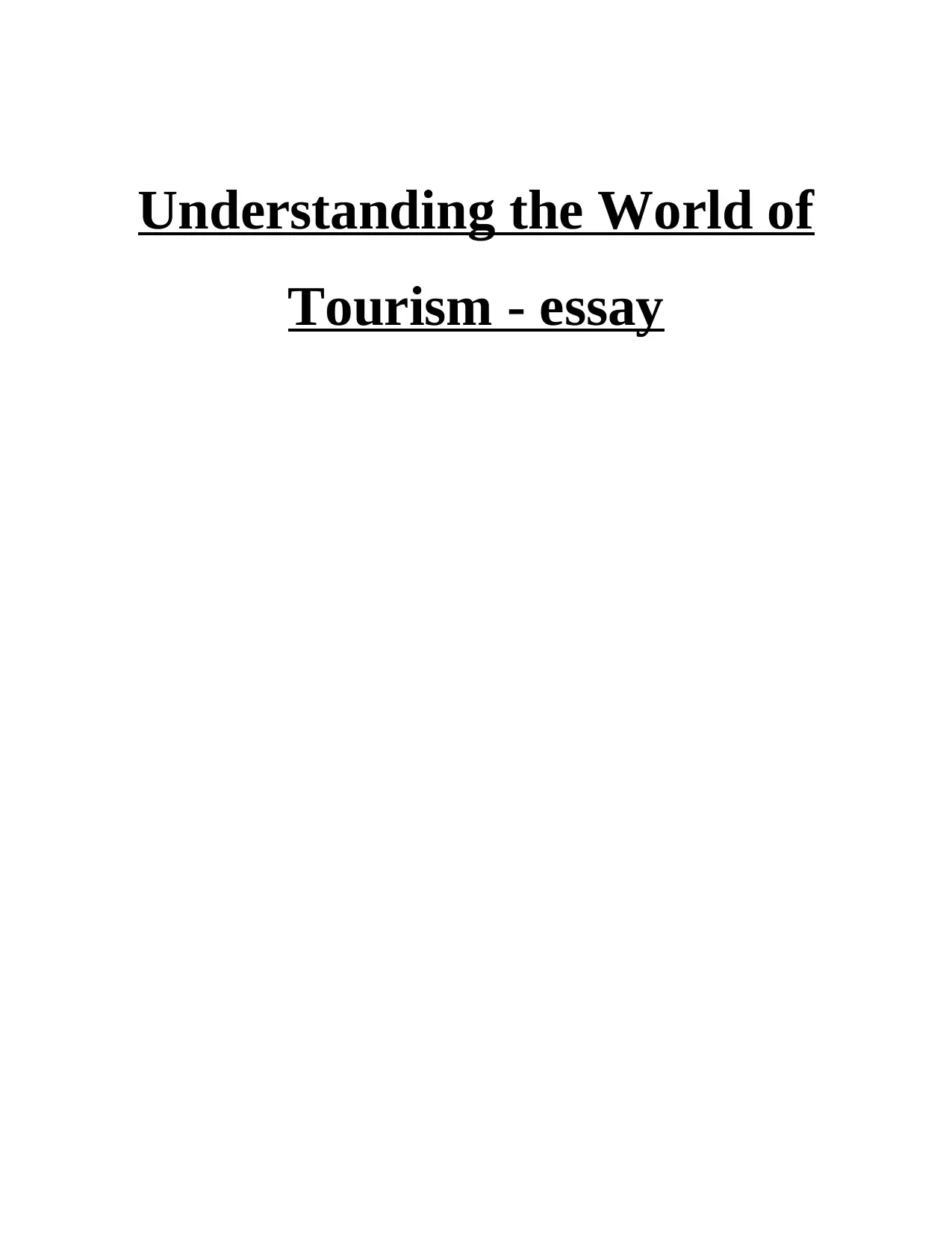
Understanding the World of
Tourism - essay
Tourism - essay
Paraphrase This Document
Need a fresh take? Get an instant paraphrase of this document with our AI Paraphraser
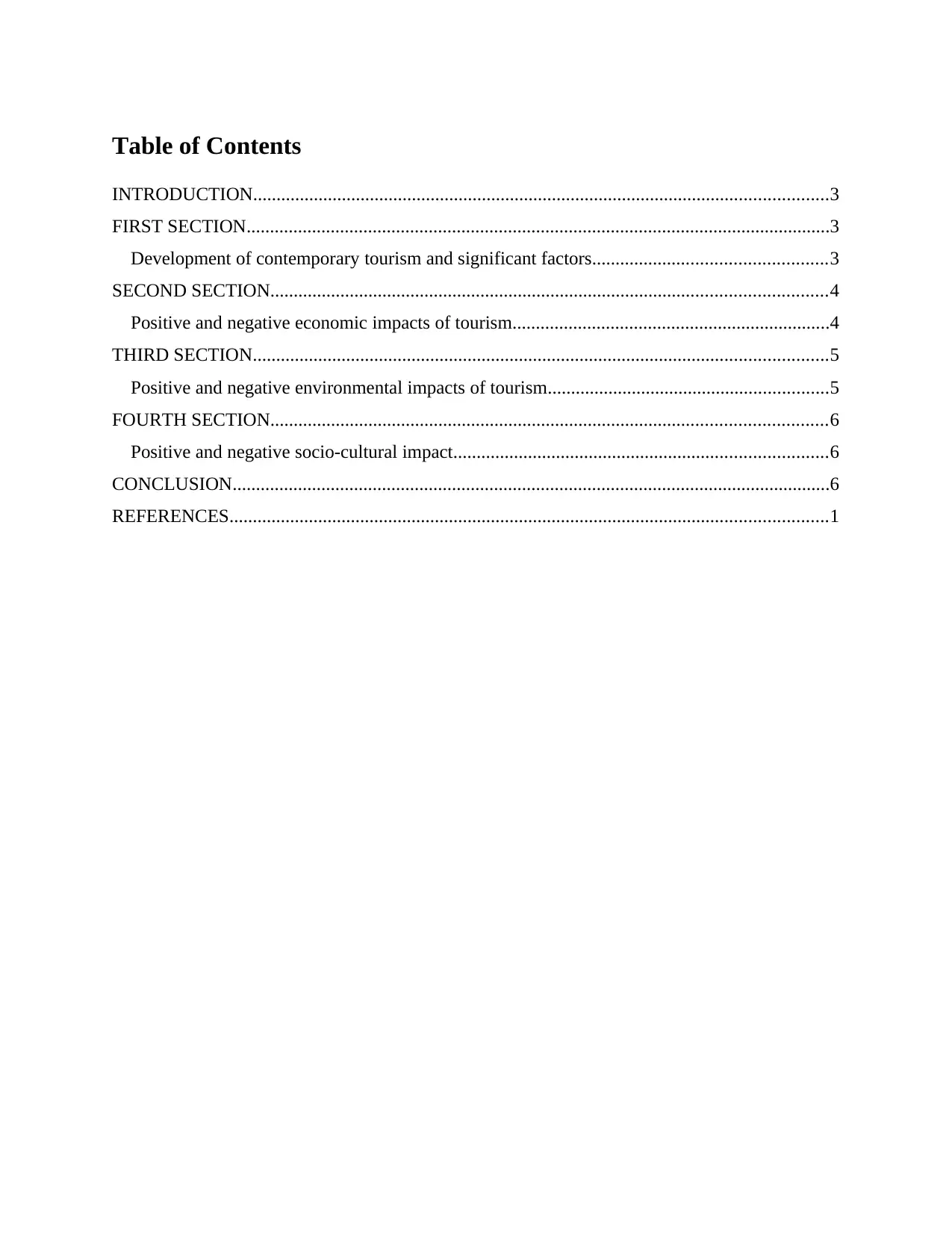
Table of Contents
INTRODUCTION...........................................................................................................................3
FIRST SECTION.............................................................................................................................3
Development of contemporary tourism and significant factors..................................................3
SECOND SECTION.......................................................................................................................4
Positive and negative economic impacts of tourism....................................................................4
THIRD SECTION...........................................................................................................................5
Positive and negative environmental impacts of tourism............................................................5
FOURTH SECTION.......................................................................................................................6
Positive and negative socio-cultural impact................................................................................6
CONCLUSION................................................................................................................................6
REFERENCES................................................................................................................................1
INTRODUCTION...........................................................................................................................3
FIRST SECTION.............................................................................................................................3
Development of contemporary tourism and significant factors..................................................3
SECOND SECTION.......................................................................................................................4
Positive and negative economic impacts of tourism....................................................................4
THIRD SECTION...........................................................................................................................5
Positive and negative environmental impacts of tourism............................................................5
FOURTH SECTION.......................................................................................................................6
Positive and negative socio-cultural impact................................................................................6
CONCLUSION................................................................................................................................6
REFERENCES................................................................................................................................1
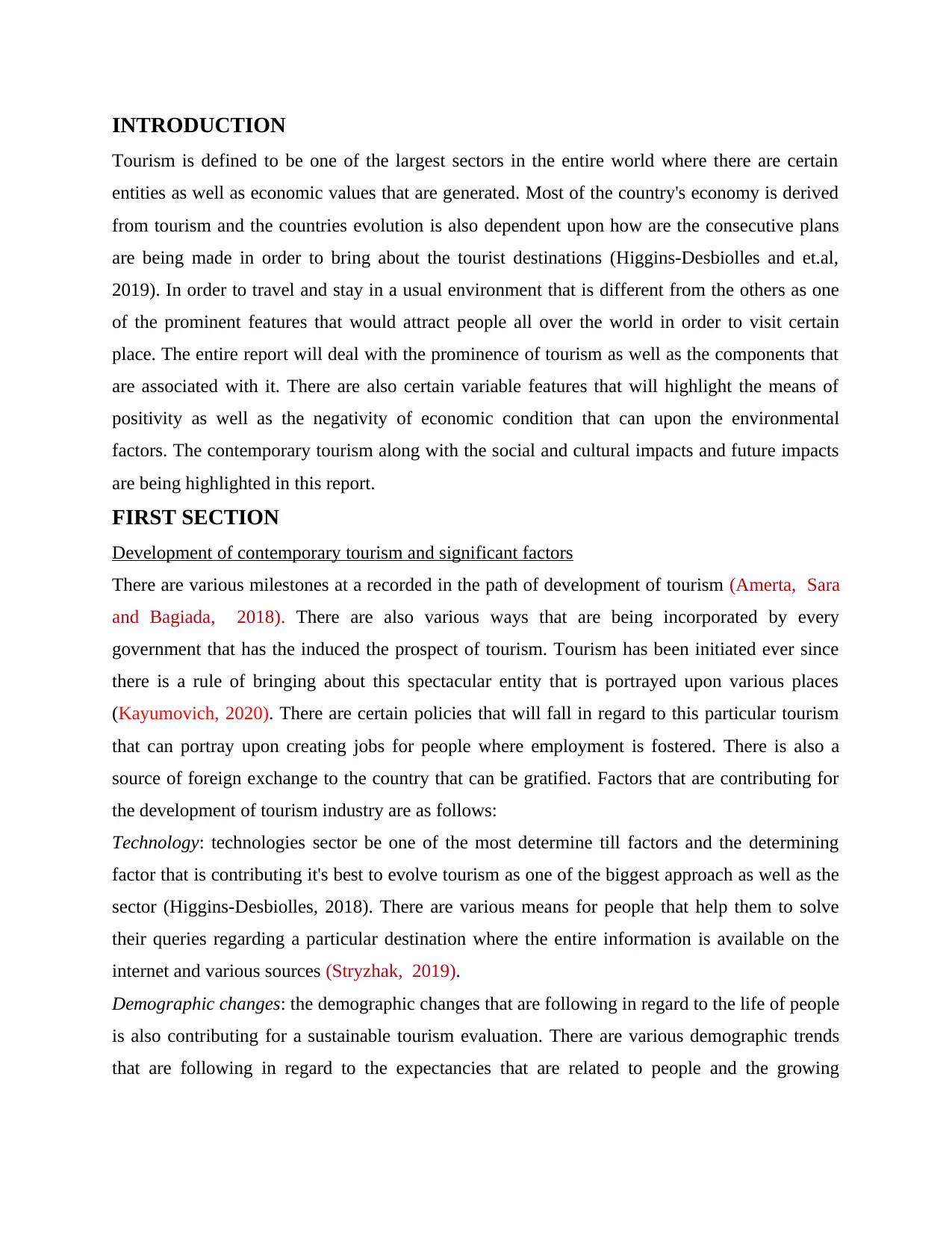
INTRODUCTION
Tourism is defined to be one of the largest sectors in the entire world where there are certain
entities as well as economic values that are generated. Most of the country's economy is derived
from tourism and the countries evolution is also dependent upon how are the consecutive plans
are being made in order to bring about the tourist destinations (Higgins-Desbiolles and et.al,
2019). In order to travel and stay in a usual environment that is different from the others as one
of the prominent features that would attract people all over the world in order to visit certain
place. The entire report will deal with the prominence of tourism as well as the components that
are associated with it. There are also certain variable features that will highlight the means of
positivity as well as the negativity of economic condition that can upon the environmental
factors. The contemporary tourism along with the social and cultural impacts and future impacts
are being highlighted in this report.
FIRST SECTION
Development of contemporary tourism and significant factors
There are various milestones at a recorded in the path of development of tourism (Amerta, Sara
and Bagiada, 2018). There are also various ways that are being incorporated by every
government that has the induced the prospect of tourism. Tourism has been initiated ever since
there is a rule of bringing about this spectacular entity that is portrayed upon various places
(Kayumovich, 2020). There are certain policies that will fall in regard to this particular tourism
that can portray upon creating jobs for people where employment is fostered. There is also a
source of foreign exchange to the country that can be gratified. Factors that are contributing for
the development of tourism industry are as follows:
Technology: technologies sector be one of the most determine till factors and the determining
factor that is contributing it's best to evolve tourism as one of the biggest approach as well as the
sector (Higgins-Desbiolles, 2018). There are various means for people that help them to solve
their queries regarding a particular destination where the entire information is available on the
internet and various sources (Stryzhak, 2019).
Demographic changes: the demographic changes that are following in regard to the life of people
is also contributing for a sustainable tourism evaluation. There are various demographic trends
that are following in regard to the expectancies that are related to people and the growing
Tourism is defined to be one of the largest sectors in the entire world where there are certain
entities as well as economic values that are generated. Most of the country's economy is derived
from tourism and the countries evolution is also dependent upon how are the consecutive plans
are being made in order to bring about the tourist destinations (Higgins-Desbiolles and et.al,
2019). In order to travel and stay in a usual environment that is different from the others as one
of the prominent features that would attract people all over the world in order to visit certain
place. The entire report will deal with the prominence of tourism as well as the components that
are associated with it. There are also certain variable features that will highlight the means of
positivity as well as the negativity of economic condition that can upon the environmental
factors. The contemporary tourism along with the social and cultural impacts and future impacts
are being highlighted in this report.
FIRST SECTION
Development of contemporary tourism and significant factors
There are various milestones at a recorded in the path of development of tourism (Amerta, Sara
and Bagiada, 2018). There are also various ways that are being incorporated by every
government that has the induced the prospect of tourism. Tourism has been initiated ever since
there is a rule of bringing about this spectacular entity that is portrayed upon various places
(Kayumovich, 2020). There are certain policies that will fall in regard to this particular tourism
that can portray upon creating jobs for people where employment is fostered. There is also a
source of foreign exchange to the country that can be gratified. Factors that are contributing for
the development of tourism industry are as follows:
Technology: technologies sector be one of the most determine till factors and the determining
factor that is contributing it's best to evolve tourism as one of the biggest approach as well as the
sector (Higgins-Desbiolles, 2018). There are various means for people that help them to solve
their queries regarding a particular destination where the entire information is available on the
internet and various sources (Stryzhak, 2019).
Demographic changes: the demographic changes that are following in regard to the life of people
is also contributing for a sustainable tourism evaluation. There are various demographic trends
that are following in regard to the expectancies that are related to people and the growing
⊘ This is a preview!⊘
Do you want full access?
Subscribe today to unlock all pages.

Trusted by 1+ million students worldwide
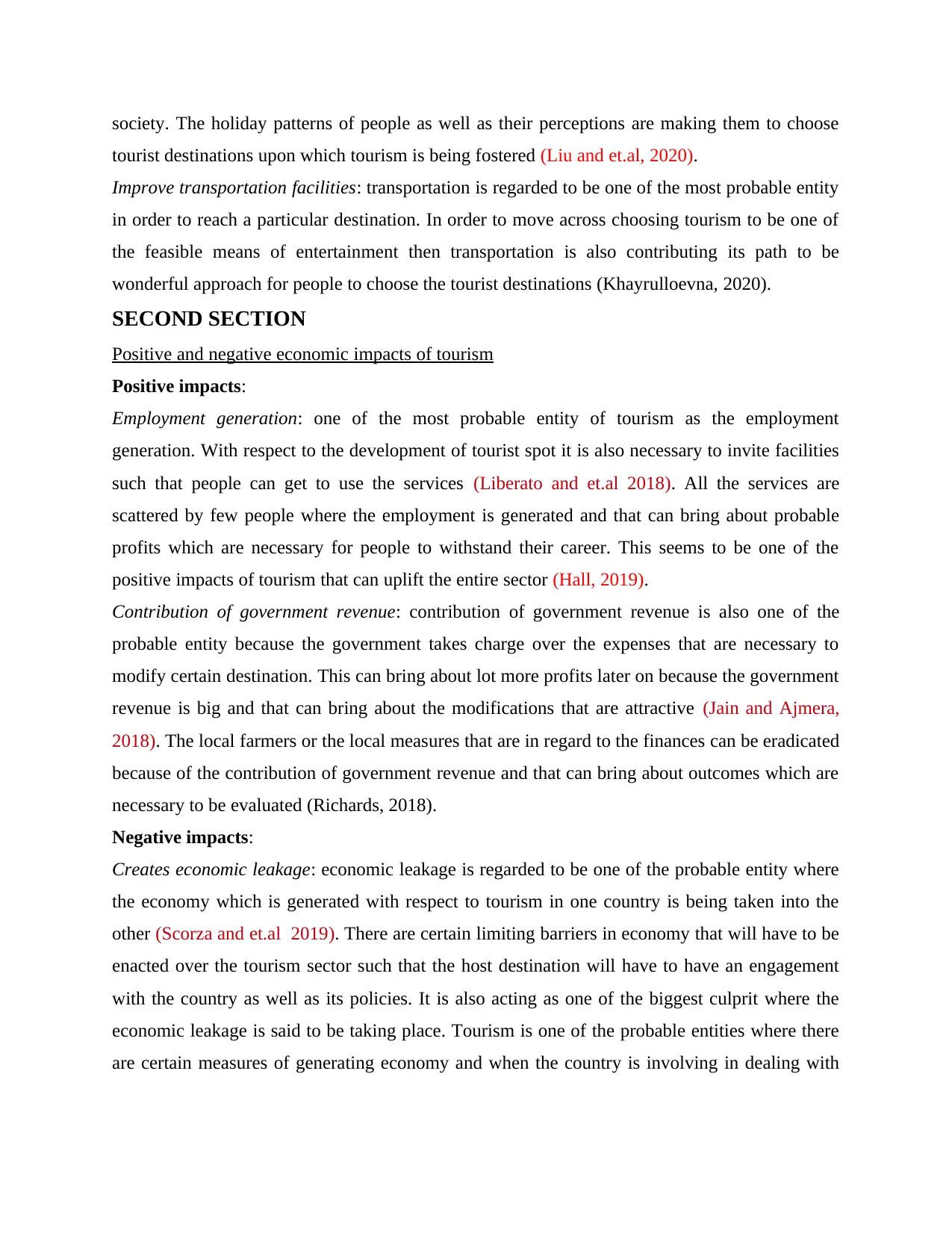
society. The holiday patterns of people as well as their perceptions are making them to choose
tourist destinations upon which tourism is being fostered (Liu and et.al, 2020).
Improve transportation facilities: transportation is regarded to be one of the most probable entity
in order to reach a particular destination. In order to move across choosing tourism to be one of
the feasible means of entertainment then transportation is also contributing its path to be
wonderful approach for people to choose the tourist destinations (Khayrulloevna, 2020).
SECOND SECTION
Positive and negative economic impacts of tourism
Positive impacts:
Employment generation: one of the most probable entity of tourism as the employment
generation. With respect to the development of tourist spot it is also necessary to invite facilities
such that people can get to use the services (Liberato and et.al 2018). All the services are
scattered by few people where the employment is generated and that can bring about probable
profits which are necessary for people to withstand their career. This seems to be one of the
positive impacts of tourism that can uplift the entire sector (Hall, 2019).
Contribution of government revenue: contribution of government revenue is also one of the
probable entity because the government takes charge over the expenses that are necessary to
modify certain destination. This can bring about lot more profits later on because the government
revenue is big and that can bring about the modifications that are attractive (Jain and Ajmera,
2018). The local farmers or the local measures that are in regard to the finances can be eradicated
because of the contribution of government revenue and that can bring about outcomes which are
necessary to be evaluated (Richards, 2018).
Negative impacts:
Creates economic leakage: economic leakage is regarded to be one of the probable entity where
the economy which is generated with respect to tourism in one country is being taken into the
other (Scorza and et.al 2019). There are certain limiting barriers in economy that will have to be
enacted over the tourism sector such that the host destination will have to have an engagement
with the country as well as its policies. It is also acting as one of the biggest culprit where the
economic leakage is said to be taking place. Tourism is one of the probable entities where there
are certain measures of generating economy and when the country is involving in dealing with
tourist destinations upon which tourism is being fostered (Liu and et.al, 2020).
Improve transportation facilities: transportation is regarded to be one of the most probable entity
in order to reach a particular destination. In order to move across choosing tourism to be one of
the feasible means of entertainment then transportation is also contributing its path to be
wonderful approach for people to choose the tourist destinations (Khayrulloevna, 2020).
SECOND SECTION
Positive and negative economic impacts of tourism
Positive impacts:
Employment generation: one of the most probable entity of tourism as the employment
generation. With respect to the development of tourist spot it is also necessary to invite facilities
such that people can get to use the services (Liberato and et.al 2018). All the services are
scattered by few people where the employment is generated and that can bring about probable
profits which are necessary for people to withstand their career. This seems to be one of the
positive impacts of tourism that can uplift the entire sector (Hall, 2019).
Contribution of government revenue: contribution of government revenue is also one of the
probable entity because the government takes charge over the expenses that are necessary to
modify certain destination. This can bring about lot more profits later on because the government
revenue is big and that can bring about the modifications that are attractive (Jain and Ajmera,
2018). The local farmers or the local measures that are in regard to the finances can be eradicated
because of the contribution of government revenue and that can bring about outcomes which are
necessary to be evaluated (Richards, 2018).
Negative impacts:
Creates economic leakage: economic leakage is regarded to be one of the probable entity where
the economy which is generated with respect to tourism in one country is being taken into the
other (Scorza and et.al 2019). There are certain limiting barriers in economy that will have to be
enacted over the tourism sector such that the host destination will have to have an engagement
with the country as well as its policies. It is also acting as one of the biggest culprit where the
economic leakage is said to be taking place. Tourism is one of the probable entities where there
are certain measures of generating economy and when the country is involving in dealing with
Paraphrase This Document
Need a fresh take? Get an instant paraphrase of this document with our AI Paraphraser
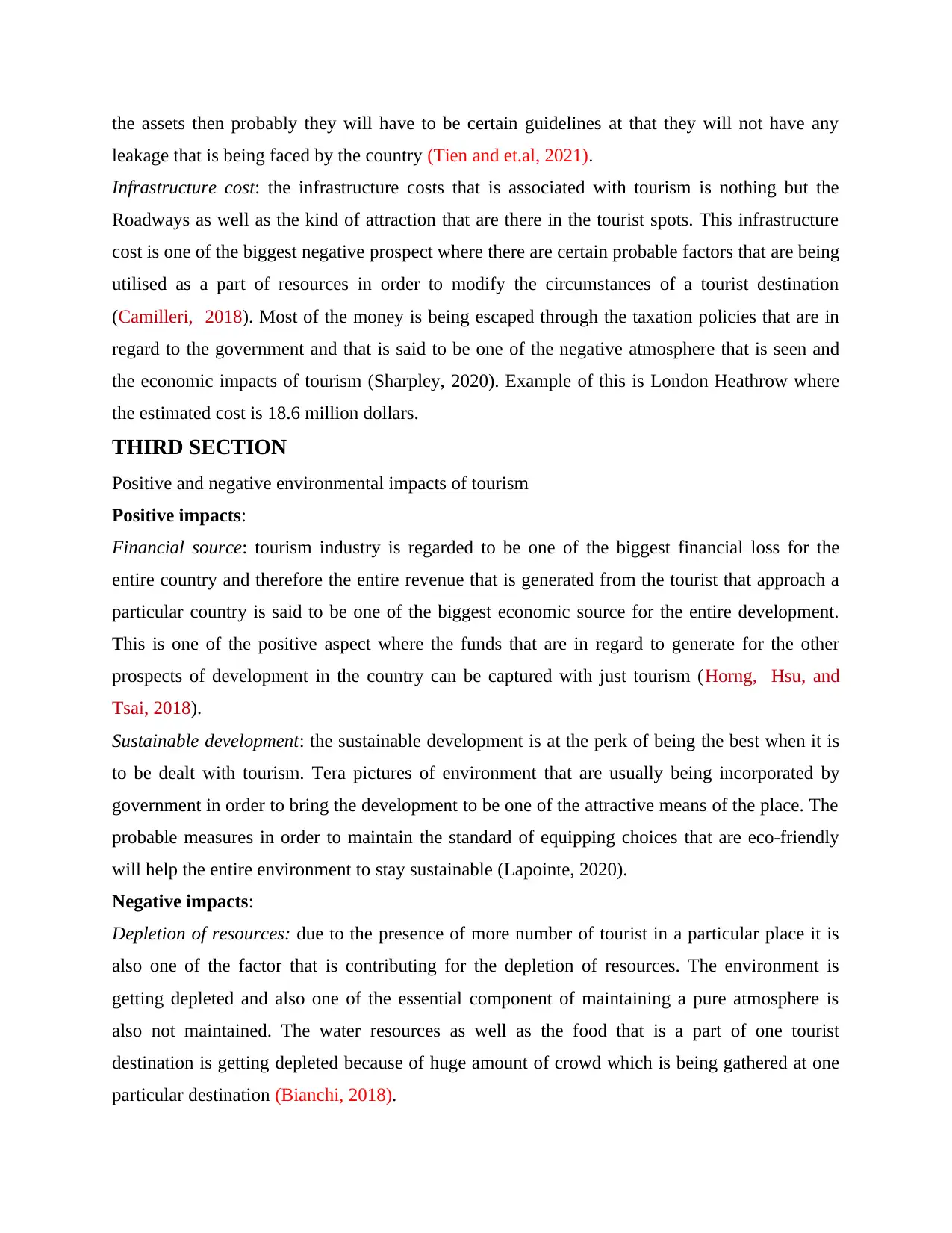
the assets then probably they will have to be certain guidelines at that they will not have any
leakage that is being faced by the country (Tien and et.al, 2021).
Infrastructure cost: the infrastructure costs that is associated with tourism is nothing but the
Roadways as well as the kind of attraction that are there in the tourist spots. This infrastructure
cost is one of the biggest negative prospect where there are certain probable factors that are being
utilised as a part of resources in order to modify the circumstances of a tourist destination
(Camilleri, 2018). Most of the money is being escaped through the taxation policies that are in
regard to the government and that is said to be one of the negative atmosphere that is seen and
the economic impacts of tourism (Sharpley, 2020). Example of this is London Heathrow where
the estimated cost is 18.6 million dollars.
THIRD SECTION
Positive and negative environmental impacts of tourism
Positive impacts:
Financial source: tourism industry is regarded to be one of the biggest financial loss for the
entire country and therefore the entire revenue that is generated from the tourist that approach a
particular country is said to be one of the biggest economic source for the entire development.
This is one of the positive aspect where the funds that are in regard to generate for the other
prospects of development in the country can be captured with just tourism (Horng, Hsu, and
Tsai, 2018).
Sustainable development: the sustainable development is at the perk of being the best when it is
to be dealt with tourism. Tera pictures of environment that are usually being incorporated by
government in order to bring the development to be one of the attractive means of the place. The
probable measures in order to maintain the standard of equipping choices that are eco-friendly
will help the entire environment to stay sustainable (Lapointe, 2020).
Negative impacts:
Depletion of resources: due to the presence of more number of tourist in a particular place it is
also one of the factor that is contributing for the depletion of resources. The environment is
getting depleted and also one of the essential component of maintaining a pure atmosphere is
also not maintained. The water resources as well as the food that is a part of one tourist
destination is getting depleted because of huge amount of crowd which is being gathered at one
particular destination (Bianchi, 2018).
leakage that is being faced by the country (Tien and et.al, 2021).
Infrastructure cost: the infrastructure costs that is associated with tourism is nothing but the
Roadways as well as the kind of attraction that are there in the tourist spots. This infrastructure
cost is one of the biggest negative prospect where there are certain probable factors that are being
utilised as a part of resources in order to modify the circumstances of a tourist destination
(Camilleri, 2018). Most of the money is being escaped through the taxation policies that are in
regard to the government and that is said to be one of the negative atmosphere that is seen and
the economic impacts of tourism (Sharpley, 2020). Example of this is London Heathrow where
the estimated cost is 18.6 million dollars.
THIRD SECTION
Positive and negative environmental impacts of tourism
Positive impacts:
Financial source: tourism industry is regarded to be one of the biggest financial loss for the
entire country and therefore the entire revenue that is generated from the tourist that approach a
particular country is said to be one of the biggest economic source for the entire development.
This is one of the positive aspect where the funds that are in regard to generate for the other
prospects of development in the country can be captured with just tourism (Horng, Hsu, and
Tsai, 2018).
Sustainable development: the sustainable development is at the perk of being the best when it is
to be dealt with tourism. Tera pictures of environment that are usually being incorporated by
government in order to bring the development to be one of the attractive means of the place. The
probable measures in order to maintain the standard of equipping choices that are eco-friendly
will help the entire environment to stay sustainable (Lapointe, 2020).
Negative impacts:
Depletion of resources: due to the presence of more number of tourist in a particular place it is
also one of the factor that is contributing for the depletion of resources. The environment is
getting depleted and also one of the essential component of maintaining a pure atmosphere is
also not maintained. The water resources as well as the food that is a part of one tourist
destination is getting depleted because of huge amount of crowd which is being gathered at one
particular destination (Bianchi, 2018).
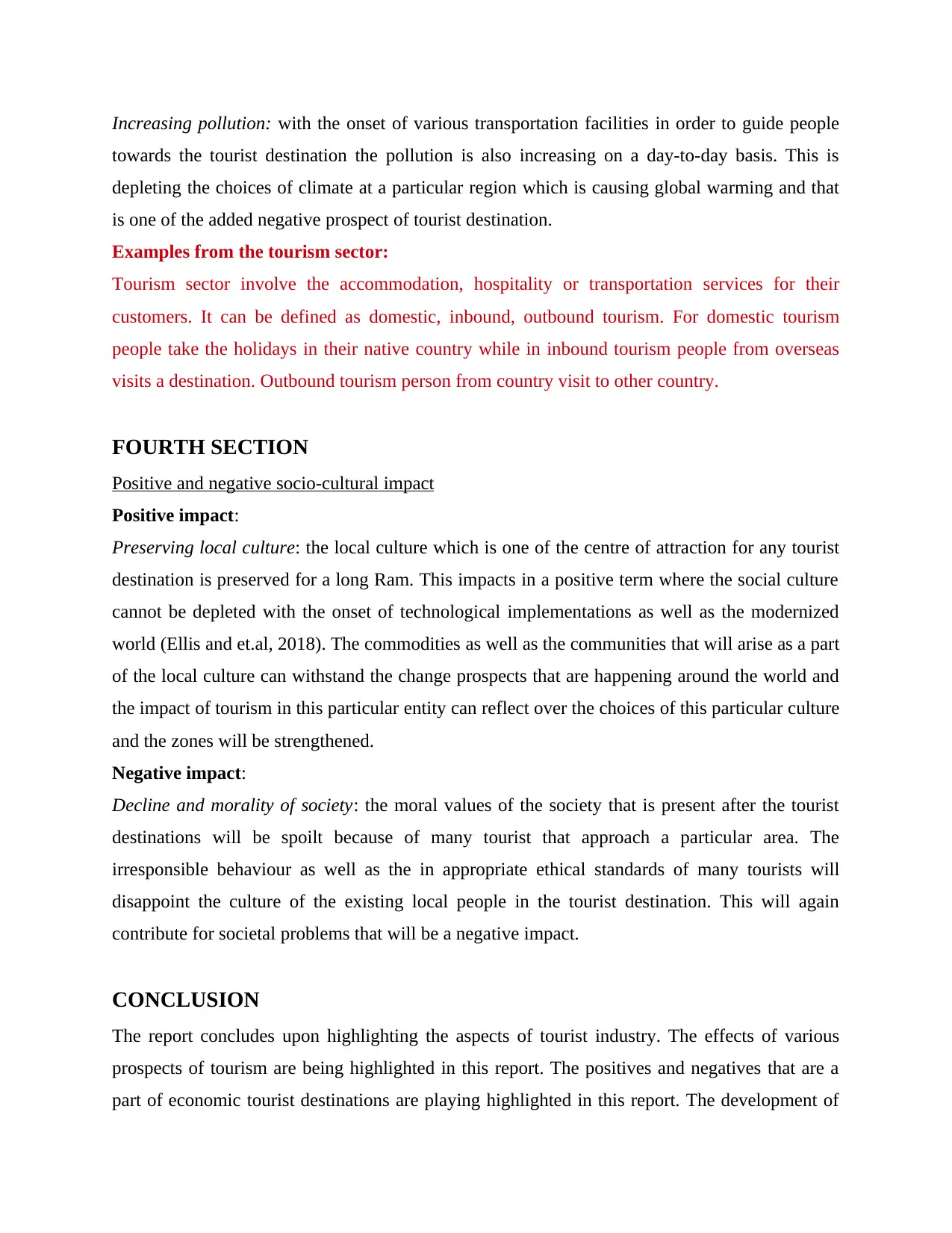
Increasing pollution: with the onset of various transportation facilities in order to guide people
towards the tourist destination the pollution is also increasing on a day-to-day basis. This is
depleting the choices of climate at a particular region which is causing global warming and that
is one of the added negative prospect of tourist destination.
Examples from the tourism sector:
Tourism sector involve the accommodation, hospitality or transportation services for their
customers. It can be defined as domestic, inbound, outbound tourism. For domestic tourism
people take the holidays in their native country while in inbound tourism people from overseas
visits a destination. Outbound tourism person from country visit to other country.
FOURTH SECTION
Positive and negative socio-cultural impact
Positive impact:
Preserving local culture: the local culture which is one of the centre of attraction for any tourist
destination is preserved for a long Ram. This impacts in a positive term where the social culture
cannot be depleted with the onset of technological implementations as well as the modernized
world (Ellis and et.al, 2018). The commodities as well as the communities that will arise as a part
of the local culture can withstand the change prospects that are happening around the world and
the impact of tourism in this particular entity can reflect over the choices of this particular culture
and the zones will be strengthened.
Negative impact:
Decline and morality of society: the moral values of the society that is present after the tourist
destinations will be spoilt because of many tourist that approach a particular area. The
irresponsible behaviour as well as the in appropriate ethical standards of many tourists will
disappoint the culture of the existing local people in the tourist destination. This will again
contribute for societal problems that will be a negative impact.
CONCLUSION
The report concludes upon highlighting the aspects of tourist industry. The effects of various
prospects of tourism are being highlighted in this report. The positives and negatives that are a
part of economic tourist destinations are playing highlighted in this report. The development of
towards the tourist destination the pollution is also increasing on a day-to-day basis. This is
depleting the choices of climate at a particular region which is causing global warming and that
is one of the added negative prospect of tourist destination.
Examples from the tourism sector:
Tourism sector involve the accommodation, hospitality or transportation services for their
customers. It can be defined as domestic, inbound, outbound tourism. For domestic tourism
people take the holidays in their native country while in inbound tourism people from overseas
visits a destination. Outbound tourism person from country visit to other country.
FOURTH SECTION
Positive and negative socio-cultural impact
Positive impact:
Preserving local culture: the local culture which is one of the centre of attraction for any tourist
destination is preserved for a long Ram. This impacts in a positive term where the social culture
cannot be depleted with the onset of technological implementations as well as the modernized
world (Ellis and et.al, 2018). The commodities as well as the communities that will arise as a part
of the local culture can withstand the change prospects that are happening around the world and
the impact of tourism in this particular entity can reflect over the choices of this particular culture
and the zones will be strengthened.
Negative impact:
Decline and morality of society: the moral values of the society that is present after the tourist
destinations will be spoilt because of many tourist that approach a particular area. The
irresponsible behaviour as well as the in appropriate ethical standards of many tourists will
disappoint the culture of the existing local people in the tourist destination. This will again
contribute for societal problems that will be a negative impact.
CONCLUSION
The report concludes upon highlighting the aspects of tourist industry. The effects of various
prospects of tourism are being highlighted in this report. The positives and negatives that are a
part of economic tourist destinations are playing highlighted in this report. The development of
⊘ This is a preview!⊘
Do you want full access?
Subscribe today to unlock all pages.

Trusted by 1+ million students worldwide
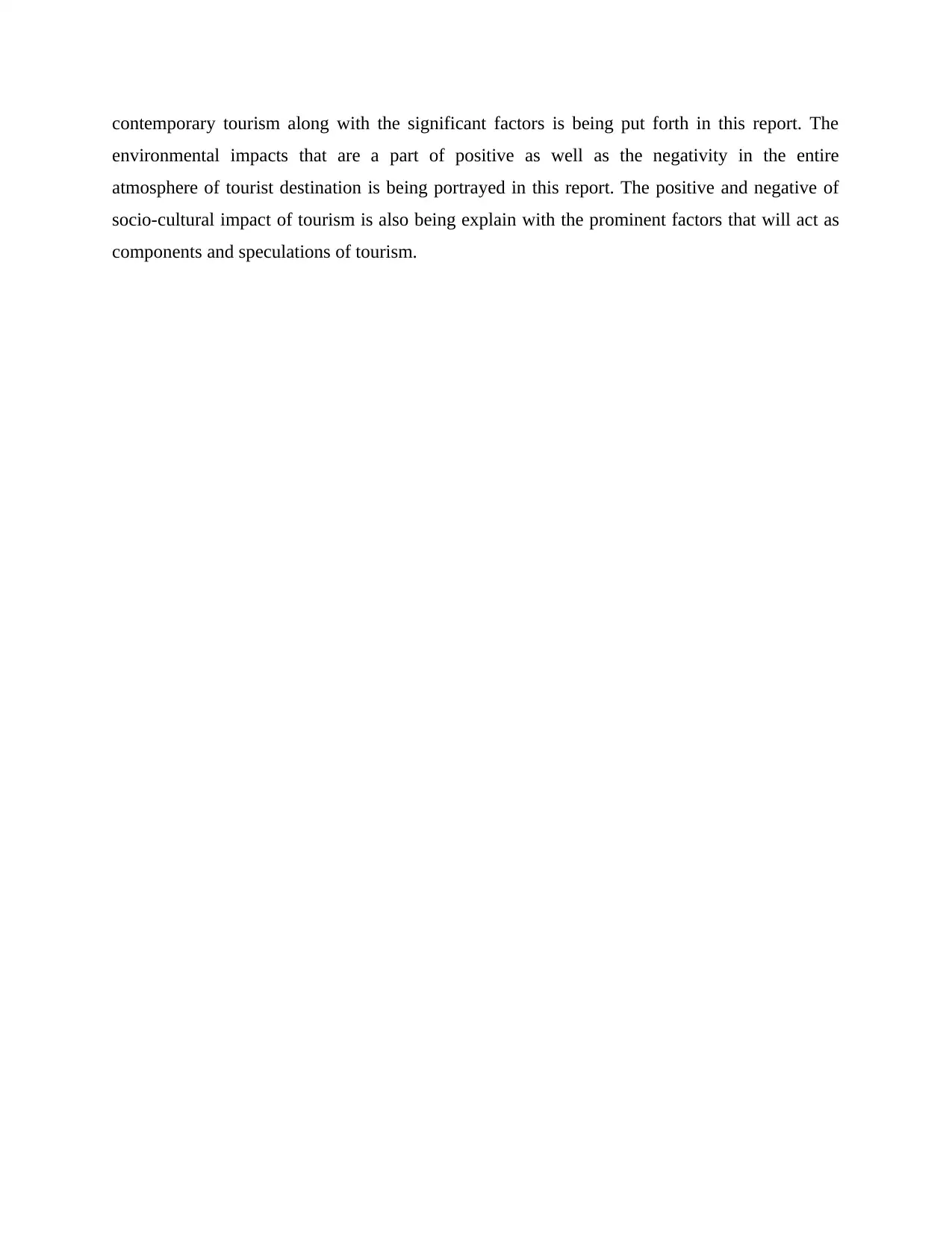
contemporary tourism along with the significant factors is being put forth in this report. The
environmental impacts that are a part of positive as well as the negativity in the entire
atmosphere of tourist destination is being portrayed in this report. The positive and negative of
socio-cultural impact of tourism is also being explain with the prominent factors that will act as
components and speculations of tourism.
environmental impacts that are a part of positive as well as the negativity in the entire
atmosphere of tourist destination is being portrayed in this report. The positive and negative of
socio-cultural impact of tourism is also being explain with the prominent factors that will act as
components and speculations of tourism.
Paraphrase This Document
Need a fresh take? Get an instant paraphrase of this document with our AI Paraphraser
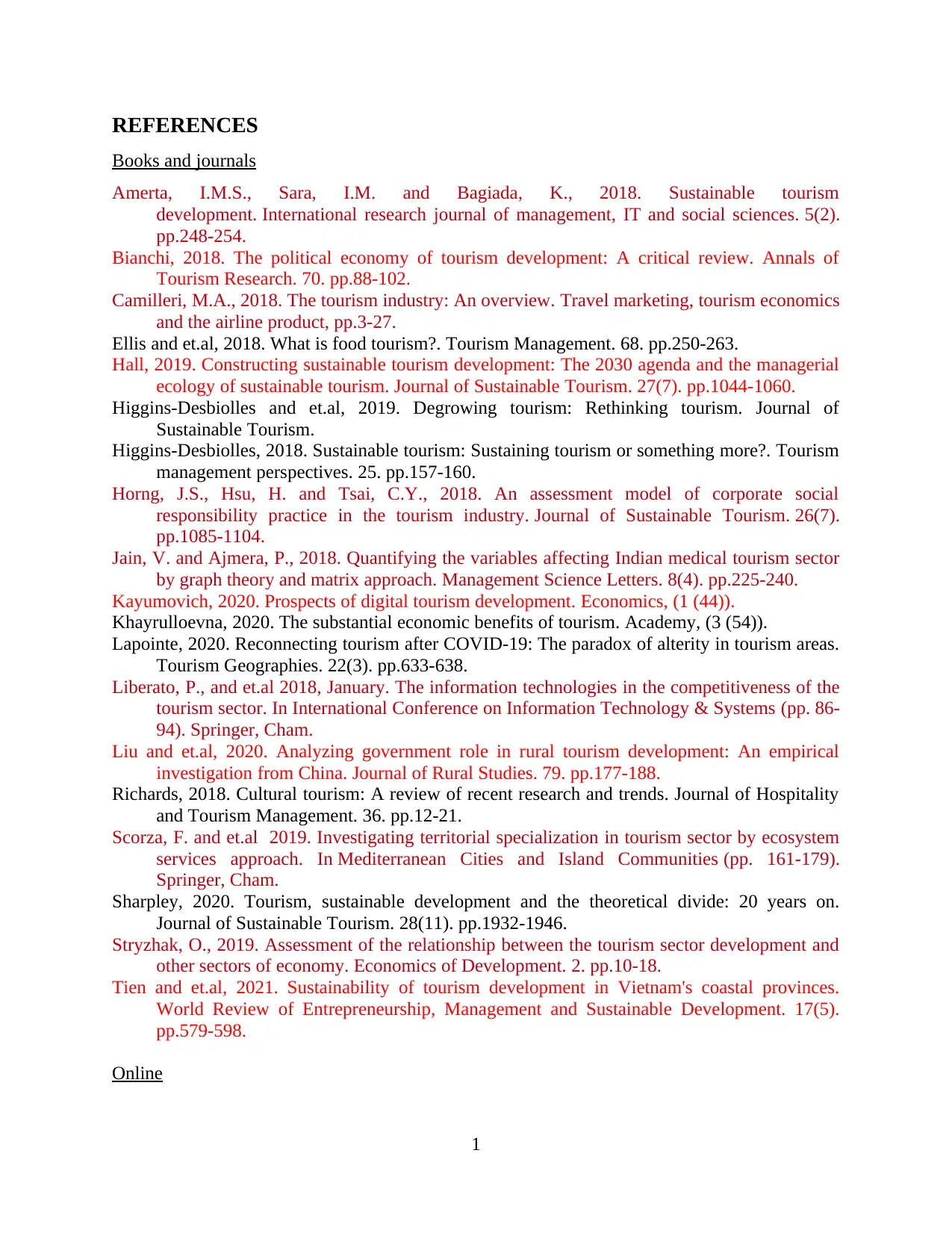
REFERENCES
Books and journals
Amerta, I.M.S., Sara, I.M. and Bagiada, K., 2018. Sustainable tourism
development. International research journal of management, IT and social sciences. 5(2).
pp.248-254.
Bianchi, 2018. The political economy of tourism development: A critical review. Annals of
Tourism Research. 70. pp.88-102.
Camilleri, M.A., 2018. The tourism industry: An overview. Travel marketing, tourism economics
and the airline product, pp.3-27.
Ellis and et.al, 2018. What is food tourism?. Tourism Management. 68. pp.250-263.
Hall, 2019. Constructing sustainable tourism development: The 2030 agenda and the managerial
ecology of sustainable tourism. Journal of Sustainable Tourism. 27(7). pp.1044-1060.
Higgins-Desbiolles and et.al, 2019. Degrowing tourism: Rethinking tourism. Journal of
Sustainable Tourism.
Higgins-Desbiolles, 2018. Sustainable tourism: Sustaining tourism or something more?. Tourism
management perspectives. 25. pp.157-160.
Horng, J.S., Hsu, H. and Tsai, C.Y., 2018. An assessment model of corporate social
responsibility practice in the tourism industry. Journal of Sustainable Tourism. 26(7).
pp.1085-1104.
Jain, V. and Ajmera, P., 2018. Quantifying the variables affecting Indian medical tourism sector
by graph theory and matrix approach. Management Science Letters. 8(4). pp.225-240.
Kayumovich, 2020. Prospects of digital tourism development. Economics, (1 (44)).
Khayrulloevna, 2020. The substantial economic benefits of tourism. Academy, (3 (54)).
Lapointe, 2020. Reconnecting tourism after COVID-19: The paradox of alterity in tourism areas.
Tourism Geographies. 22(3). pp.633-638.
Liberato, P., and et.al 2018, January. The information technologies in the competitiveness of the
tourism sector. In International Conference on Information Technology & Systems (pp. 86-
94). Springer, Cham.
Liu and et.al, 2020. Analyzing government role in rural tourism development: An empirical
investigation from China. Journal of Rural Studies. 79. pp.177-188.
Richards, 2018. Cultural tourism: A review of recent research and trends. Journal of Hospitality
and Tourism Management. 36. pp.12-21.
Scorza, F. and et.al 2019. Investigating territorial specialization in tourism sector by ecosystem
services approach. In Mediterranean Cities and Island Communities (pp. 161-179).
Springer, Cham.
Sharpley, 2020. Tourism, sustainable development and the theoretical divide: 20 years on.
Journal of Sustainable Tourism. 28(11). pp.1932-1946.
Stryzhak, O., 2019. Assessment of the relationship between the tourism sector development and
other sectors of economy. Economics of Development. 2. pp.10-18.
Tien and et.al, 2021. Sustainability of tourism development in Vietnam's coastal provinces.
World Review of Entrepreneurship, Management and Sustainable Development. 17(5).
pp.579-598.
Online
1
Books and journals
Amerta, I.M.S., Sara, I.M. and Bagiada, K., 2018. Sustainable tourism
development. International research journal of management, IT and social sciences. 5(2).
pp.248-254.
Bianchi, 2018. The political economy of tourism development: A critical review. Annals of
Tourism Research. 70. pp.88-102.
Camilleri, M.A., 2018. The tourism industry: An overview. Travel marketing, tourism economics
and the airline product, pp.3-27.
Ellis and et.al, 2018. What is food tourism?. Tourism Management. 68. pp.250-263.
Hall, 2019. Constructing sustainable tourism development: The 2030 agenda and the managerial
ecology of sustainable tourism. Journal of Sustainable Tourism. 27(7). pp.1044-1060.
Higgins-Desbiolles and et.al, 2019. Degrowing tourism: Rethinking tourism. Journal of
Sustainable Tourism.
Higgins-Desbiolles, 2018. Sustainable tourism: Sustaining tourism or something more?. Tourism
management perspectives. 25. pp.157-160.
Horng, J.S., Hsu, H. and Tsai, C.Y., 2018. An assessment model of corporate social
responsibility practice in the tourism industry. Journal of Sustainable Tourism. 26(7).
pp.1085-1104.
Jain, V. and Ajmera, P., 2018. Quantifying the variables affecting Indian medical tourism sector
by graph theory and matrix approach. Management Science Letters. 8(4). pp.225-240.
Kayumovich, 2020. Prospects of digital tourism development. Economics, (1 (44)).
Khayrulloevna, 2020. The substantial economic benefits of tourism. Academy, (3 (54)).
Lapointe, 2020. Reconnecting tourism after COVID-19: The paradox of alterity in tourism areas.
Tourism Geographies. 22(3). pp.633-638.
Liberato, P., and et.al 2018, January. The information technologies in the competitiveness of the
tourism sector. In International Conference on Information Technology & Systems (pp. 86-
94). Springer, Cham.
Liu and et.al, 2020. Analyzing government role in rural tourism development: An empirical
investigation from China. Journal of Rural Studies. 79. pp.177-188.
Richards, 2018. Cultural tourism: A review of recent research and trends. Journal of Hospitality
and Tourism Management. 36. pp.12-21.
Scorza, F. and et.al 2019. Investigating territorial specialization in tourism sector by ecosystem
services approach. In Mediterranean Cities and Island Communities (pp. 161-179).
Springer, Cham.
Sharpley, 2020. Tourism, sustainable development and the theoretical divide: 20 years on.
Journal of Sustainable Tourism. 28(11). pp.1932-1946.
Stryzhak, O., 2019. Assessment of the relationship between the tourism sector development and
other sectors of economy. Economics of Development. 2. pp.10-18.
Tien and et.al, 2021. Sustainability of tourism development in Vietnam's coastal provinces.
World Review of Entrepreneurship, Management and Sustainable Development. 17(5).
pp.579-598.
Online
1

Tourist destinations: [Online]. Available through: < Tourist Destinations – World Travel Guides
(tourist-destinations.com) >
2
(tourist-destinations.com) >
2
⊘ This is a preview!⊘
Do you want full access?
Subscribe today to unlock all pages.

Trusted by 1+ million students worldwide
1 out of 9
Related Documents
Your All-in-One AI-Powered Toolkit for Academic Success.
+13062052269
info@desklib.com
Available 24*7 on WhatsApp / Email
![[object Object]](/_next/static/media/star-bottom.7253800d.svg)
Unlock your academic potential
Copyright © 2020–2025 A2Z Services. All Rights Reserved. Developed and managed by ZUCOL.

